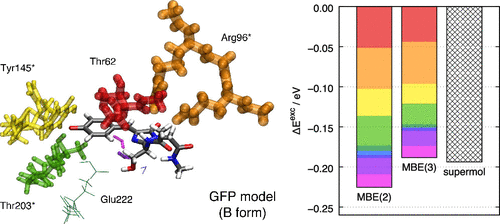当前位置:
X-MOL 学术
›
J. Chem. Theory Comput.
›
论文详情
Our official English website, www.x-mol.net, welcomes your feedback! (Note: you will need to create a separate account there.)
Protein Response Effects on Cofactor Excitation Energies from First Principles: Augmenting Subsystem Time-Dependent Density-Functional Theory with Many-Body Expansion Techniques
Journal of Chemical Theory and Computation ( IF 5.5 ) Pub Date : 2021-09-15 , DOI: 10.1021/acs.jctc.1c00551 Linus Scholz 1 , Johannes Neugebauer 1
Journal of Chemical Theory and Computation ( IF 5.5 ) Pub Date : 2021-09-15 , DOI: 10.1021/acs.jctc.1c00551 Linus Scholz 1 , Johannes Neugebauer 1
Affiliation

|
We investigate the possibility of describing protein response effects on a chromophore excitation by means of subsystem time-dependent density-functional theory (sTDDFT) in combination with a many-body expansion (MBE) approach. While sTDDFT is in principle intrinsically able to include such contributions, addressing cofactor excitations in protein models or entire proteins with full environment-response treatments is currently out of reach. Taking different model structures of the green fluorescent protein (GFP) and bovine rhodopsin as examples, we demonstrate that an embedded-MBE approach based on sTDDFT in its simplest version leads to a good agreement of the predicted protein response effect already at second order. To reproduce reference response effects from nonsubsystem TDDFT calculations quantitatively (error ≤ 5%), however, a third- or even fourth-order MBE may be required. For the latter case, we explore a selective inclusion of fourth-order terms that drastically reduces the computational burden. In addition, we demonstrate how this sTDDFT-MBE treatment can be utilized as an analysis tool to identify residues with dominant response contributions. This, in turn, can be employed to arrive at smaller structural models for light-absorbing proteins, which still feature all of the main characteristics in terms of photoresponse properties.
中文翻译:

蛋白质响应对辅因子激发能量的第一性原理的影响:使用多体扩展技术增强子系统时间相关密度泛函理论
我们研究了通过子系统时间依赖密度泛函理论 (sTDDFT) 结合多体扩展 (MBE) 方法来描述蛋白质响应对生色团激发的影响的可能性。虽然 sTDDFT 原则上本质上能够包括这些贡献,但目前无法通过完整的环境响应处理来解决蛋白质模型或整个蛋白质中的辅因子激发。以绿色荧光蛋白 (GFP) 和牛视紫红质的不同模型结构为例,我们证明了基于 sTDDFT 的嵌入式 MBE 方法在其最简单的版本中与预测的蛋白质反应效果已经在二阶具有良好的一致性。然而,为了从非子系统 TDDFT 计算中定量重现参考响应效应(误差 ≤ 5%),可能需要三阶甚至四阶 MBE。对于后一种情况,我们探索选择性地包含四阶项,从而大大减少计算负担。此外,我们展示了如何将此 sTDDFT-MBE 处理用作分析工具来识别具有显性响应贡献的残基。反过来,这可以用于为吸光蛋白质建立更小的结构模型,这些模型仍然具有光响应特性方面的所有主要特征。
更新日期:2021-10-12
中文翻译:

蛋白质响应对辅因子激发能量的第一性原理的影响:使用多体扩展技术增强子系统时间相关密度泛函理论
我们研究了通过子系统时间依赖密度泛函理论 (sTDDFT) 结合多体扩展 (MBE) 方法来描述蛋白质响应对生色团激发的影响的可能性。虽然 sTDDFT 原则上本质上能够包括这些贡献,但目前无法通过完整的环境响应处理来解决蛋白质模型或整个蛋白质中的辅因子激发。以绿色荧光蛋白 (GFP) 和牛视紫红质的不同模型结构为例,我们证明了基于 sTDDFT 的嵌入式 MBE 方法在其最简单的版本中与预测的蛋白质反应效果已经在二阶具有良好的一致性。然而,为了从非子系统 TDDFT 计算中定量重现参考响应效应(误差 ≤ 5%),可能需要三阶甚至四阶 MBE。对于后一种情况,我们探索选择性地包含四阶项,从而大大减少计算负担。此外,我们展示了如何将此 sTDDFT-MBE 处理用作分析工具来识别具有显性响应贡献的残基。反过来,这可以用于为吸光蛋白质建立更小的结构模型,这些模型仍然具有光响应特性方面的所有主要特征。



























 京公网安备 11010802027423号
京公网安备 11010802027423号